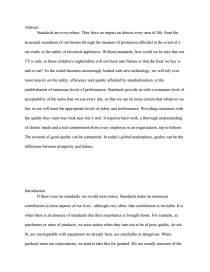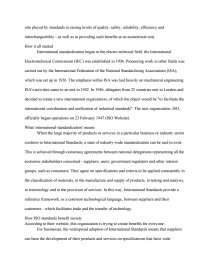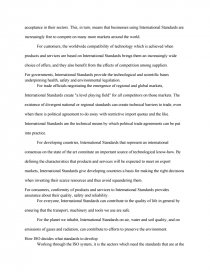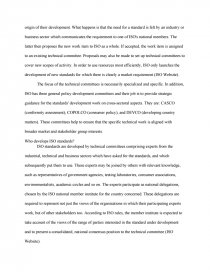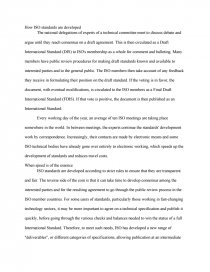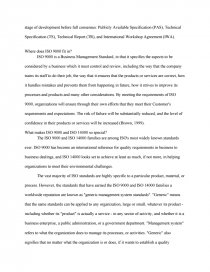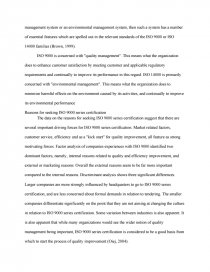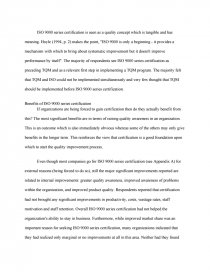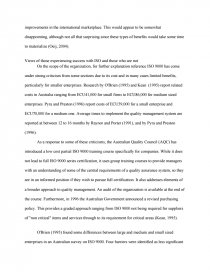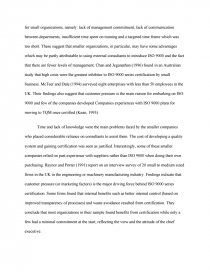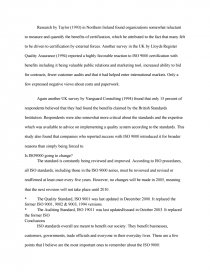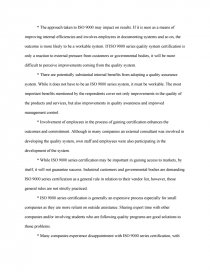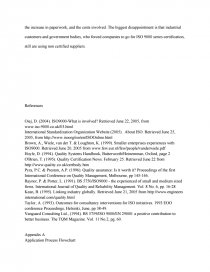International Standardization Organization And Its Role In The Business Environment
Essay by 24 • November 30, 2010 • 3,843 Words (16 Pages) • 2,469 Views
Essay Preview: International Standardization Organization And Its Role In The Business Environment
Abstract
Standards are everywhere. They have an impact on almost every area of life, from the structural soundness of our homes through the measure of protection afforded in the event of a car crash, to the safety of electrical appliances. Without standards, how could we be sure that our TV is safe, or those children's nightclothes will not burst into flames or that the food we buy is safe to eat? As the world becomes increasingly loaded with new technology, we will rely ever more heavily on the safety, efficiency and quality afforded by standardization, or the establishment of minimum levels of performance. Standards provide us with a minimum level of acceptability of the items that we use every day, so that we can be more certain that whatever we buy or use will meet the appropriate levels of safety and performance. Providing customers with the quality they want may look easy but it isn't. It requires hard work, a thorough understanding of clients' needs and a real commitment from every employee in an organization, top to bottom. The rewards of good quality can be substantial. In today's global marketplace, quality can be the difference between prosperity and failure.
Introduction
If there were no standards, we would soon notice. Standards make an enormous contribution to most aspects of our lives - although very often, that contribution is invisible. It is when there is an absence of standards that their importance is brought home. For example, as purchasers or users of products, we soon notice when they turn out to be of poor quality, do not fit, are incompatible with equipment we already have, are unreliable or dangerous. When products meet our expectations, we tend to take this for granted. We are usually unaware of the role played by standards in raising levels of quality, safety, reliability, efficiency and interchangeability - as well as in providing such benefits at an economical cost.
How it all started
International standardization began in the electro technical field: the International Electrotechnical Commission (IEC) was established in 1906. Pioneering work in other fields was carried out by the International Federation of the National Standardizing Associations (ISA), which was set up in 1926. The emphasis within ISA was laid heavily on mechanical engineering. ISA's activities came to an end in 1942. In 1946, delegates from 25 countries met in London and decided to create a new international organization, of which the object would be "to facilitate the international coordination and unification of industrial standards". The new organization, ISO, officially began operations on 23 February 1947 (ISO Website).
What 'international standardization' means
When the large majority of products or services in a particular business or industry sector conform to International Standards, a state of industry-wide standardization can be said to exist. This is achieved through consensus agreements between national delegations representing all the economic stakeholders concerned - suppliers, users, government regulators and other interest groups, such as consumers. They agree on specifications and criteria to be applied consistently in the classification of materials, in the manufacture and supply of products, in testing and analysis, in terminology and in the provision of services. In this way, International Standards provide a reference framework, or a common technological language, between suppliers and their customers - which facilitates trade and the transfer of technology.
How ISO standards benefit society
According to their website, this organization is trying to create benefits for everyone.
For businesses, the widespread adoption of International Standards means that suppliers can base the development of their products and services on specifications that have wide acceptance in their sectors. This, in turn, means that businesses using International Standards are increasingly free to compete on many more markets around the world.
For customers, the worldwide compatibility of technology which is achieved when products and services are based on International Standards brings them an increasingly wide choice of offers, and they also benefit from the effects of competition among suppliers.
For governments, International Standards provide the technological and scientific bases underpinning health, safety and environmental legislation.
For trade officials negotiating the emergence of regional and global markets, International Standards create "a level playing field" for all competitors on those markets. The existence of divergent national or regional standards can create technical barriers to trade, even when there is political agreement to do away with restrictive import quotas and the like. International Standards are the technical means by which political trade agreements can be put into practice.
For developing countries, International Standards that represent an international consensus on the state of the art constitute an important source of technological know-how. By defining the characteristics that products and services will be expected to meet on export markets, International Standards give developing countries a basis for making the right decisions when investing their scarce resources and thus avoid squandering them.
For consumers, conformity of products and services to International Standards provides assurance about their quality, safety and reliability.
For everyone, International Standards can contribute to the quality of life in general by ensuring that the transport, machinery and tools we use are safe.
For the planet we inhabit, International Standards on air, water and soil quality, and on emissions of gases and radiation, can contribute to efforts to preserve the environment.
How ISO decides what standards to develop
Working through the ISO system, it is the sectors which need the standards that are at the origin of their development. What happens is that the need for a standard is felt by an industry or business sector which communicates the requirement to one of ISO's national members. The latter then proposes the new work item to ISO as a whole. If accepted, the work item is assigned to an existing technical committee. Proposals may also be made to set up technical committees to cover new scopes of activity. In order to use resources most efficiently, ISO only launches the development of new standards for which there
...
...
